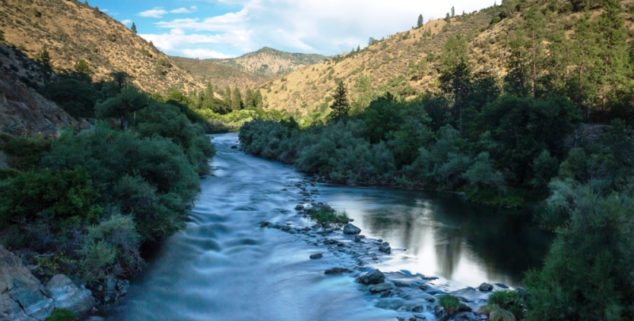News
Historic accord reached on Klamath river dam removal
 A stretch of the Klamath River in far northern California near the Oregon line. (Photo: Victoria Ditkovsky, via Shutterstock)
A stretch of the Klamath River in far northern California near the Oregon line. (Photo: Victoria Ditkovsky, via Shutterstock)The governors of California and Oregon, leaders of the Yurok and Karuk Tribes, PacificCorps and billionaire investor Warren Buffett announced a landmark, $450 million agreement Tuesday to remove four dams on the Klamath river to restore dwindling salmon populations.
The pact, which culminates decades of discussions and political feuding between tribal leaders, environmentalists, farmers and state authorities, among others, will “provide additional resources and support to advance the most ambitious salmon restoration effort in history,” a joint statement said.
Govs. Gavin Newsom of California and Kate Brown of Oregon, tribal leaders and representatives of state government and Berkshire Hathaway announced the agreement during a video hookup.
California will pick up $250 million of the price tag, and PacificCorp ratepayers will provide $200 million.
Buffett’s Berkshire Hathaway group controls PacificCorps, an electricity utility with customers in Oregon and far northern California, which operates the dams.
“I recognize the importance of Klamath dam removal and river restoration for tribal people in the Klamath Basin,” Buffett said in a written statement.
California will pick up $250 million of the price tag, and PacificCorp ratepayers will provide $200 million.
The agreement involves the removal of the four dams — three in far northern California and the fourth in Oregon — in three years. The dams, including one more than a century old, have been blamed for decades for the dramatic declines in salmon and steelhead populations.
“We more confident than ever that future generations of Karuk will enjoy the benefits of a healthy Klamath River…” — Karuk Tribe Chair Russell “Buster” Attebery
The announcement declared that the dam-removal memorandum of understanding will “improve river health and renew tribal communities and cultures.”
“The river is not doing well, and neither are the salmon that call it home,” Newsom said.
“As Yurok tribal people, it is our sacred duty to bring balance to the Klamath River,” Yurok Tribe Chair Joseph James said. “At its heart, dam removal is about healing and restoration for the river, for the salmon, and for our people.”
Karuk Tribe Chair Russell “Buster” Attebery said, “We more confident than ever that future generations of Karuk will enjoy the benefits of a healthy Klamath River…”
While much paperwork and assent from the Federal Energy Regulatory Commission, or FERC, is required, the way is now cleared for “the largest river restoration project in the history of this nation,” Newsom added.
Not everyone was happy with the agreement.
California Rep. Doug LaMalfa (R), whose congressional district includes three of the dams, said in a written statement that the deal “will do nothing to help fish but will destroy water storage needed for firefighting and will bankrupt Siskiyou County.”
Barring unexpected delays, actual removal of the dams will occur in 2023, depending on funding availability.
“The dams themselves are a benefit to our overloaded power grid and the local area economy. Especially in a year where power is a precious commodity and in short supply at times…,” he added.
Tuesday’s announcement is the latest chapter in years of negotiations that created the nonprofit Klamath River Renewal Corp., set to assume ownership of the dams and pursue their demolition. FERC earlier this year blocked a plan, crafted by the Obama administration, to oversee removal of the dams, and Berkshire Hathaway was not eager to pursue demolition without protection against liability, which has now shifted to the states.
But the project moved forward after Newsom made a personal appeal to Buffet.
Brown said the agreement creates “a path for a future everyone can share.”
Barring unexpected delays, actual removal of the dams will occur in 2023, depending on funding availability.
The memorandum of agreement provides that the state legislatures will be asked for appropriations if there are unexpected cost overruns, a move that made Berkshire Hathaway comfortable enough to proceed.
The four dams generate relatively minor amounts of hydroelectric power and Berkshire Hathaway was not eager to go through the cumbersome process of relicensing them.
“The salmon and steelhead that were once abundant in this great watershed are now at risk of extinction…” — Yurok Chair Joseph James.
The Klamath River flows 257 miles through Oregon and northern California and empties into the Pacific Ocean below Crescent City in Del Norte County, about 20 miles south of the Oregon border. It is the second largest river in California after the Sacramento River.
The tribes for generations have depended on the river for sustenance.
But the Klamath salmon and steelhead populations dwindled dramatically. In one year, 2004, the tribes harvested only 100 salmon in the river. Two years earlier, an estimated 68,000 fish died in a matter of days.
“This represents the largest fish kill in US history. The fish kill was caused by an infection that spread rapidly in the shallow, warm waters of the Klamath — a situation created by a combination of low flows from the Upper Klamath Irrigation Project and water quality degradation by the dams,” wrote Craig Tucker, the Klamath River Campaign Coordinator and an advocate for dam removal.
“The salmon and steelhead that were once abundant in this great watershed are now at risk of extinction, a preventable disaster that can be averted by moving forward with the planned removal of four aging hydroelectric dams,” Yurok Chair James wrote in March.
Want to see more stories like this? Sign up for The Roundup, the free daily newsletter about California politics from the editors of Capitol Weekly. Stay up to date on the news you need to know.
Sign up below, then look for a confirmation email in your inbox.

Leave a Reply